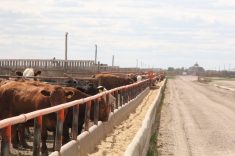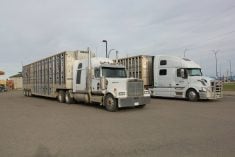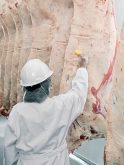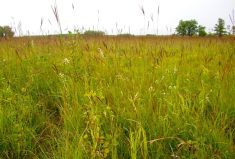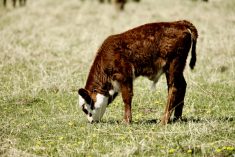Research that’s underway now won’t solve this year’s drought, but it should help us deal with the next one. By the same token, research done during the big drought of the early 2000s provides some valuable lessons about managing the cow herd in today’s drought.
Dr. Cheryl Waldner of the Western College of Veterinary Medicine in Saskatoon led a large beef cow productivity study from the start of the 2001 breeding season through weaning in 2002. This corresponded to the widespread drought that had an impact on much of Western North America and inspired the original Hay West program.
Read Also

What to know before you go to Agribition 2025
If you’re attending Agribition 2025, this is the place to find out about tickets, dates and what’s happening this year.
What they did: They examined factors affecting the productivity of over 30,000 beef cows in more than 200 well-managed herds across Alberta, Saskatchewan and the Peace region of B.C. Participating producers individually identified each cow and calf, recorded all calf births, maintained an active veterinary-client-patient relationship, had good animal handling facilities, pregnancy tested all breeding females, had a veterinarian evaluate all herd bulls, had an established spring or summer breeding season, and worked with the research team to collect the needed samples and data.
What they learned: Drought had significant impacts, even in these well-managed herds.
Abortion (Theriogenology 81:840-848; doi.org/10.1016/j.theriogenology.2013.12.016). The average abortion risk was 1.7 per cent but exceeded seven per cent in some herds. The odds of abortion were 1.6 times higher in cows with a suboptimal body condition score (below a score of three on the five-point Canadian system or a five on the nine-point American body condition scale) compared to cows in better condition. Cows that lost more condition during pregnancy were also more likely to abort than cows that maintained or improved body condition.
Stillbirth (Livestock Science 163:126-139; dx.doi.org/10.1016/j.livsci.2014.01.032). The average risk of stillbirth was 2.7 per cent but exceeded six per cent in some herds. Calves born to cows in suboptimal body condition were more than twice as likely to be dead at, or soon after, birth than calves from cows in better body condition. Rainfall played a role as well; even after accounting for body condition, abortion was more likely in regions that received less than 200 mm (eight inches) of rain during the previous growing season.
Preweaning mortalities (Can. Vet. J. 51:1227-1238; pubmed.ncbi.nlm.nih.gov/21286322/; and Can. J. Anim. Sci. 97:65-82; dx.doi.org/10.1139/cjas-2016-0055). During the 2001-02 study, the average risk that a calf would die before weaning was four per cent, with nearly half of those dying within three days of birth. Nutritional deficiencies were responsible for more deaths than infectious diseases. Two of the most common deficiencies in calves were vitamins A and E. All vitamins have a wide variety of essential functions, but A and E both have roles in the immune system. Calves that were deficient in vitamin A were nearly three times more likely to die, calves that were deficient in vitamin E were more than twice as likely to get scours and calves that were deficient in both A and E were nearly three times as likely to die than those that had adequate levels of one or both vitamins.
So what does this mean: Drought cuts forage yields, but it also cuts forage quality. Vitamins A and E are most abundant in green, leafy forage, but levels drop when forage is cut, dried or stored for winter. Last summer’s forage wasn’t overly green or leafy, so vitamin A and E levels were probably low, and are almost certainly lower now, especially if you’re feeding older hay or more straw than usual. Calves get their nutrients through the placenta during gestation, from colostrum at birth or the milk in the first few months of life. Thin or nutritionally deficient cows on nutritionally deficient diets or pastures without appropriate supplementation will raise nutrient-deficient calves that have a much higher risk of becoming sick or dying.
Even before Christmas, significant problems linked to poor body condition and nutritional deficiencies were showing up in cow herds throughout the Prairies. Deficiencies are not just about energy and vitamins. High sulphates are a common problem in many parts of the Prairies; these can bind copper and cause a secondary copper deficiency. Evaporation concentrated the sulphates in many dugouts, greatly increasing copper deficiency risks.
If you haven’t already, call your veterinarian and/or nutritionist to discuss what your cows (and especially your bred heifers) need for a successful calving season, what to look for and how to cost-effectively correct potential nutritional deficiencies in the cowherd and their calves (e.g. injectable vitamin E and selenium to prevent white muscle disease).
Doing the right things won’t prevent every problem, but it will mean fewer and smaller problems. Not testing your feed or appropriately supplementing energy, protein, vitamin and (micro)mineral levels to save money in the short term will probably be a more risky and costly strategy in the longer term, especially if it means losing calves after wintering the cow herd on expensive but poor-quality feed.
The Beef Cattle Research Council is funded by the Canadian Beef Cattle Check-Off. The BCRC partners with Agriculture and Agri-Food Canada, provincial beef industry groups and governments to advance research and technology transfer supporting the Canadian beef industry’s vision to be recognized as a preferred supplier of healthy, high-quality beef, cattle and genetics.




